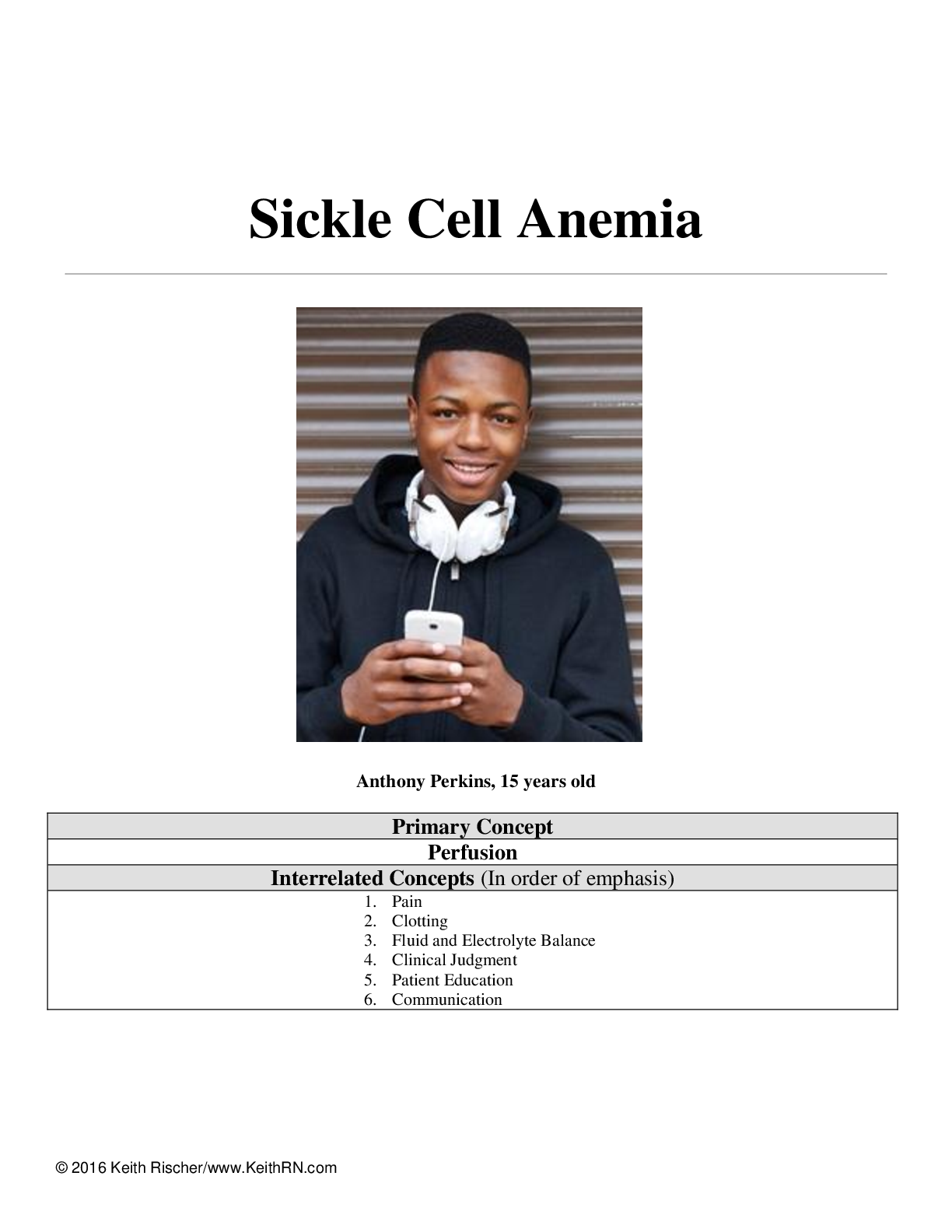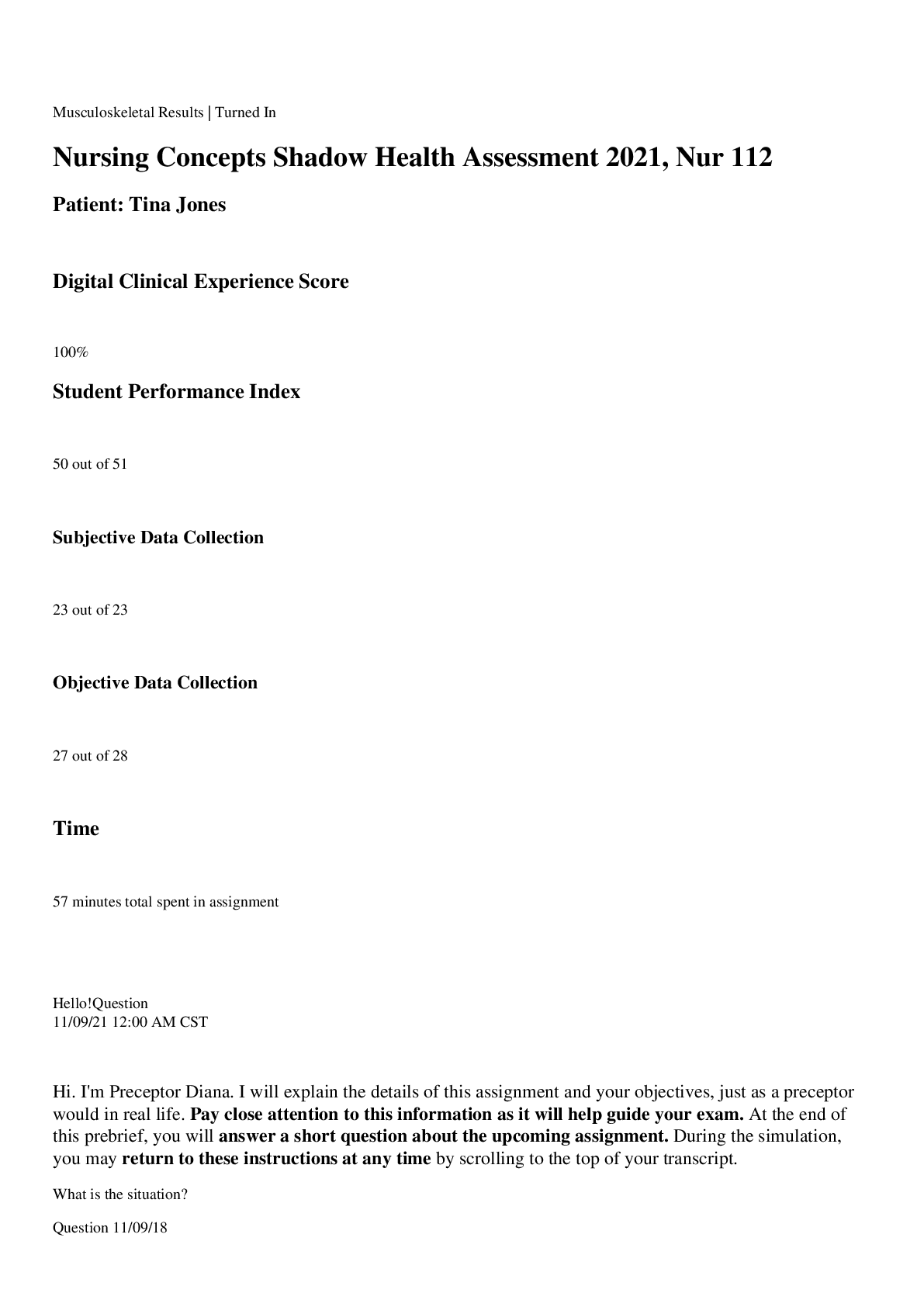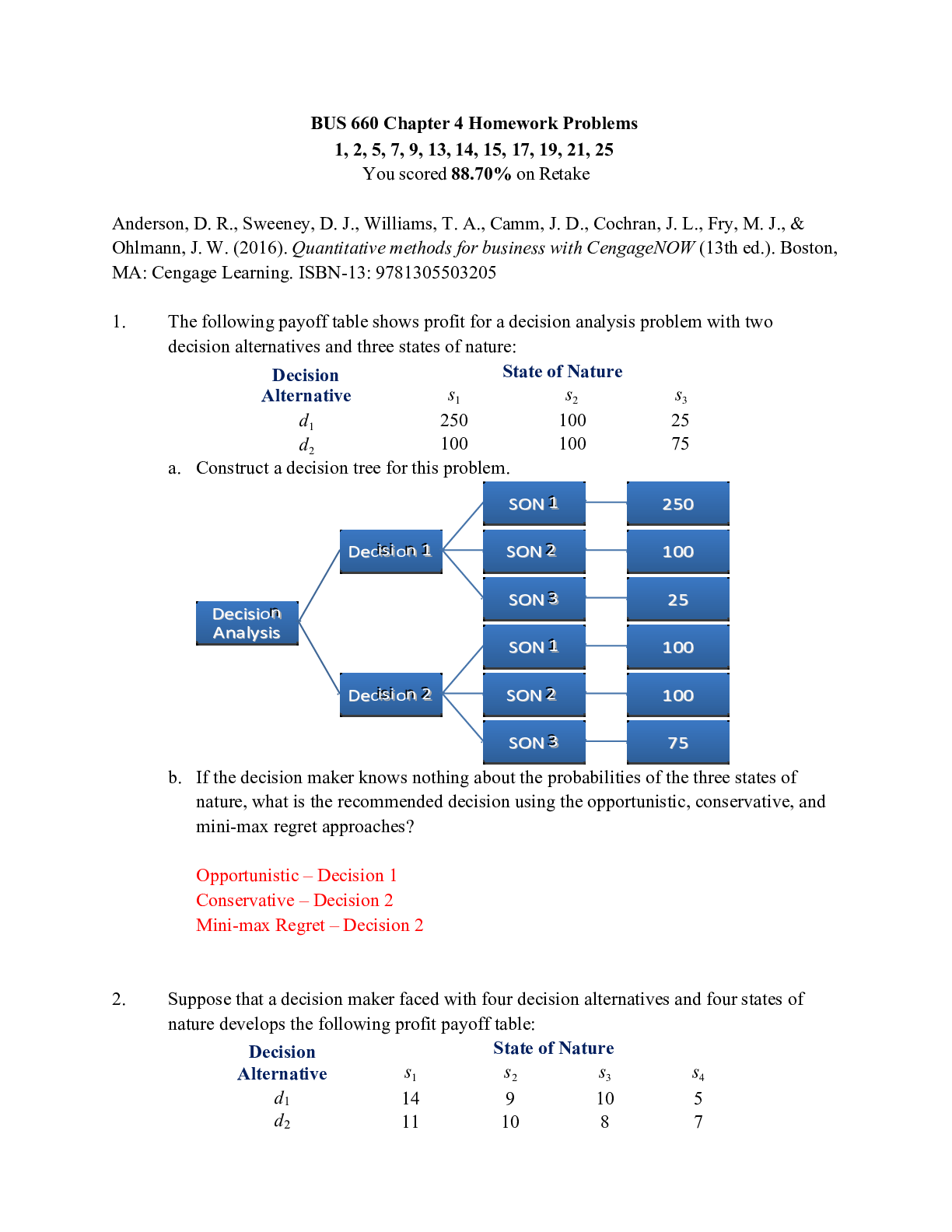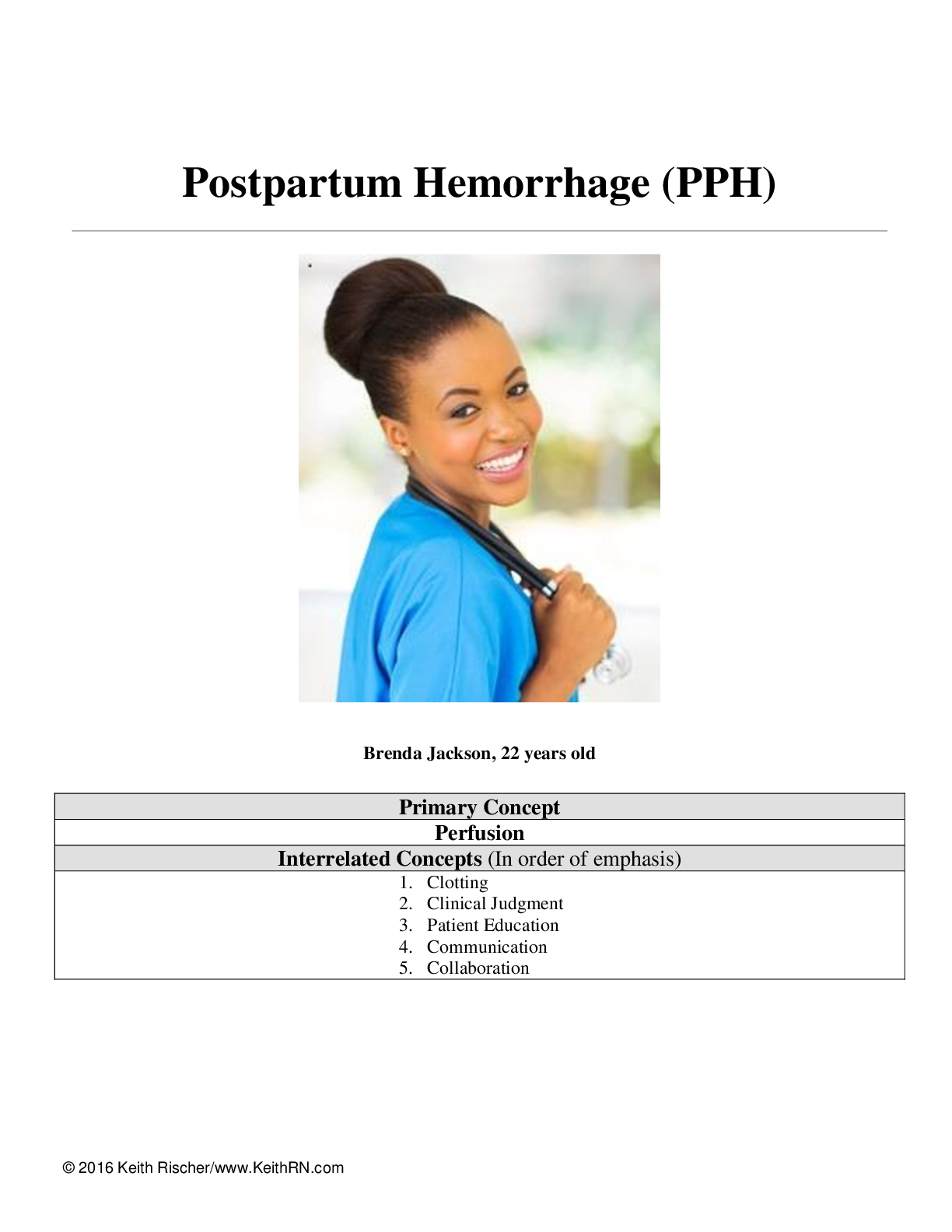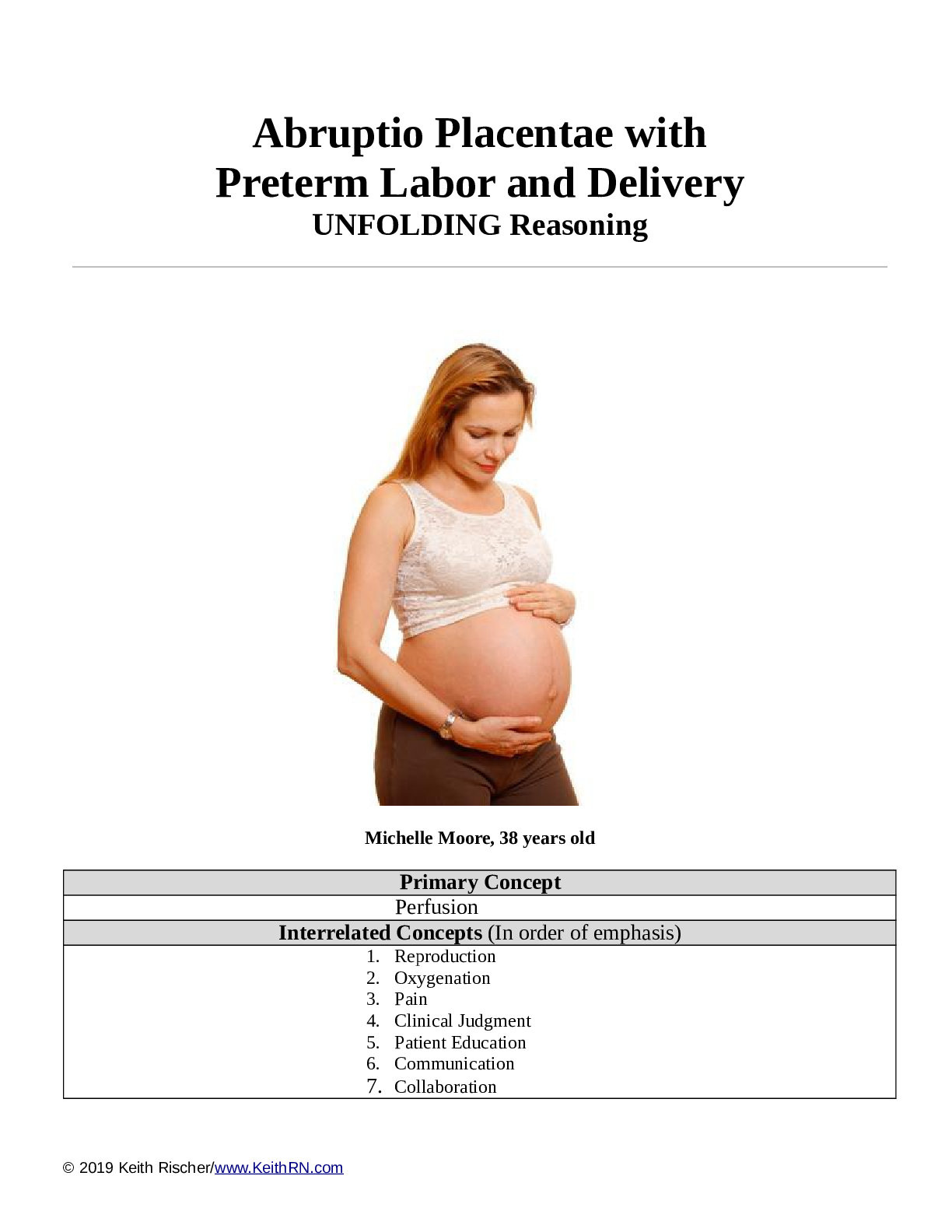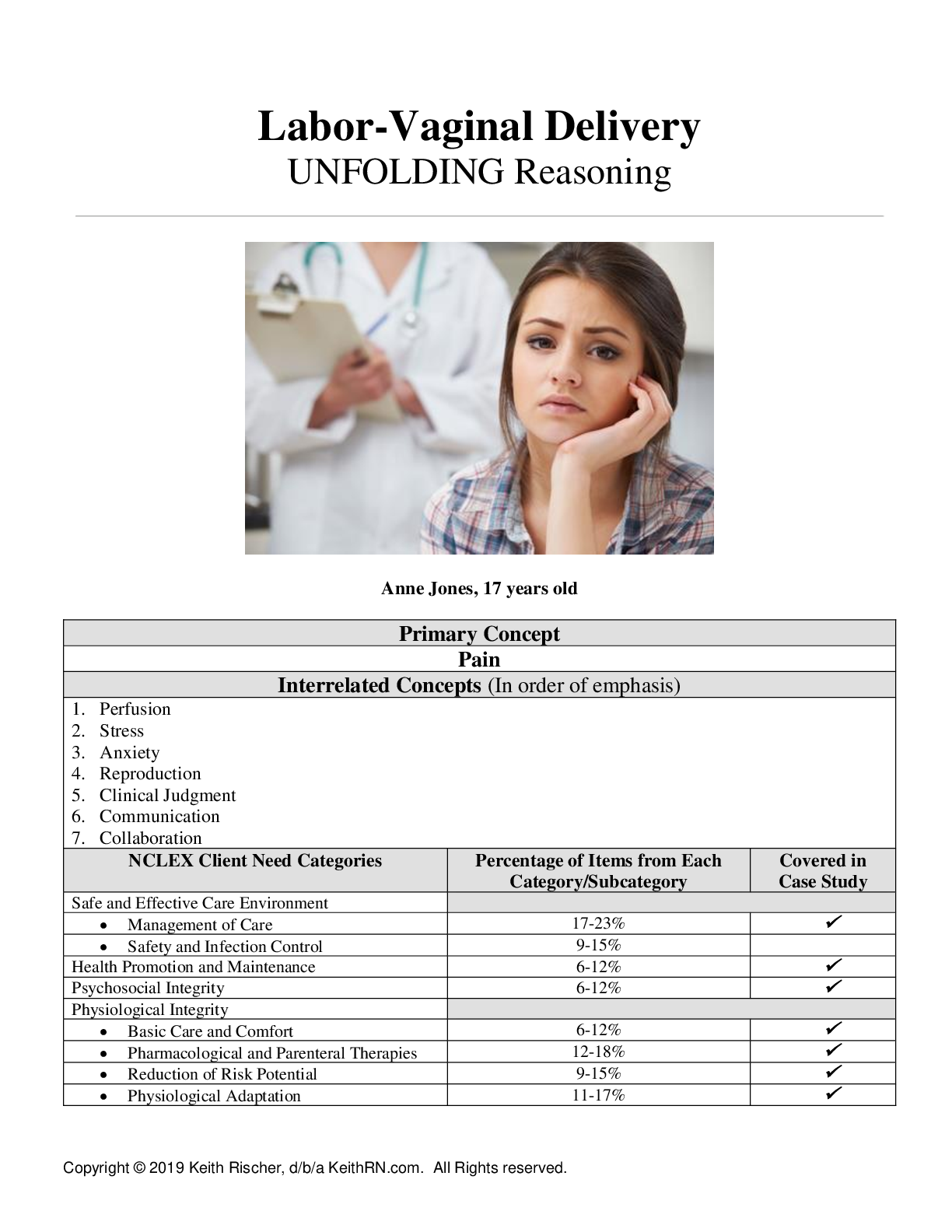*NURSING > SHADOW HEALTH > Assessment & Reasoning Cardiac System John Gordon, 65 years old (All)
Assessment & Reasoning Cardiac System John Gordon, 65 years old
Document Content and Description Below
Assessment & Reasoning Cardiac System John Gordon, 65 years old © 2019 Keith Rischer/www.KeithRN.com Assessment & Reasoning Cardiac System John Gordon, 65 years old Suggested Cardiac Nursing Ass... essment Skills to Be Demonstrated: Anterior: Inspection • Chest pulsations, heaves, lifts, color of skin; symmetry of movement; anatomical defects, retractions Palpation • Apical impulse (4th to 5th ICS, Left MCL) Auscultation • HR & rhythm (60-100 bpm) • Identify S1 & S2 – 2nd ICS, Right sternal border (aortic); 2nd ICS, Left sternal border (pulmonic); 3rd ICS, Left sternal border (Erbs); 4th ICS, Left sternal border (tricuspid); 5th ICS, Left MCL (pulmonic). S1 is louder at Apex, S2 louder at the base. This is the traditional method and a systematic method of learning. • Diaphragm and bell to be used. Do not allow the patient to hold breath. Auscultate for S3 and S4 heart sounds and murmurs. May be done in lying and sitting position, lying on left side and on back with head elevated 30 degrees Peripheral Arms: • Inspection –for symmetry, skin characteristics, hair distributions size (edema), venous pattern, color • Palpation – temperature using back of the hand, cap. refill Pulses • Palpation of radial/ulnar pulses, if suspecting arterial insufficiency, palpate brachial artery Legs: • Inspection – for symmetry, skin characteristics, hair distributions, size(edema), venous pattern, color, varicosities, thrombophlebitis • Palpation – edema, temperature, inguinal lymph nodes, • Pulses - femoral, popliteal, pedal Make Learning Active! • Role play or go through the interview/body assessment process – student to student or as a group. • Review the case study as an application exercise in small groups or together as a class. • Depending on your program some of this content in the case study may not have been taught. Do not let that prevent you from utilizing this case study! Instead, use it to promote learning by having students identify what they do not yet know and provide guidance on where they can find the information in the textbook or on the internet to address knowledge gaps. This is educational best practice and another way to scaffold knowledge! This study source was downloaded by 100000826504961 from CourseHero.com on 06-20-2022 06:21:13 GMT -05:00 https://www.coursehero.com/file/71174337/STUDENT-KEITH-RN-CARDIAC-Assessment-and-Reasoningpdf/© 2019 Keith Rischer/www.KeithRN.com Present Problem: John Gordon is a 65-year-old male who has a history of myocardial infarction (MI) two years ago and heart failure with a current ejection fraction (EF) of 30%. He presents to the emergency department (ED) for increasing shortness of breath (SOB) for the past three days. He is more fatigued than usual and becomes short of breath with minimal activity. The last two nights he had to sleep upright in a recliner so he could breathe easier and fall asleep. He has noted increased swelling in his lower legs and has gained six pounds the last two days. What data from the present problem are RELEVANT and must be interpreted as clinically significant by the nurse? (Reduction of Risk Potential) RELEVANT Data from Present Problem: Clinical Significance: What is the RELATIONSHIP of your patient’s past medical history (PMH) and current meds? (Which medication treats which condition? Draw lines to connect.) PMH: Home Meds: Pharm. Class: Mechanism of Action (own words): Myocardial infarction Ischemic cardiomyopathy w/ejection fraction 30% Aspirin 81 mg PO daily Lisinopril 20 mg PO daily Carvedilol 25 mg PO BID Patient Care Begins: What vital signs are abnormal? What is the reason (pathophysiology) for these findings? (Reduction of Risk Potential/Health Promotion and Maintenance) Abnormal VS: Clinical Significance: Current VS: P-Q-R-S-T Pain Assessment (5th VS): T: 98.6 F/37.0 C (oral) Provoking/Palliative: P: 92 (reg) Quality: Denies Pain R: 26 (reg) Region/Radiation: BP: 162/84 MAP: 110 Severity: O2 sat: 91% room air Timing: You place John on a cardiac monitor, continuous oximetry and quickly collect the following assessment data: This study source was downloaded by 100000826504961 from CourseHero.com on 06-20-2022 06:21:13 GMT -05:00 https://www.coursehero.com/file/71174337/STUDENT-KEITH-RN-CARDIAC-Assessment-and-Reasoningpdf/© 2019 Keith Rischer/www.KeithRN.com What assessment findings are abnormal? What is the reason (pathophysiology) for these findings? (Reduction of Risk Potential/Health Promotion & Maintenance) RELEVANT Assessment Data: Clinical Significance: Put it All Together and Think Like a Nurse! 1. Interpreting relevant clinical data, what is the primary problem? What body system(s) will you assess most thoroughly based on the primary/priority concern? What’s the problem? What’s causing the problem? (explain pathophysiology in OWN words) PRIORITY Body System to Assess: 2. Which specific nursing assessments for this body system are most important? Validate successful completion of each nursing assessment on a manikin (if available) identified with peer or faculty initials. PRIORITY Nursing Assessments: Rationale: Validate Student Performance: Current Assessment: GENERAL APPEARANCE: Appears anxious, restless RESP: Breath sounds have coarse crackles on inspiration and expiration scattered throughout both lung fields ant/post, labored respiratory effort, patient sitting upright CARDIAC: Forehead diaphoretic, cool to the touch, radial, pedal and post-tibial pulses regular 3+, has 3+ pitting edema bilateral lower extremities in feet, ankles, 2+ up to knees bilat, S3 gallop most prominent over apex, no jugular venous distention (JVD) noted sitting up at 45 degrees NEURO: Alert and oriented to person, place, time, and situation (x4) GI: Abdomen pale soft/nontender, symmetrical, bowel sounds audible per auscultation in all four quadrants GU: Voiding without difficulty, urine clear/yellow IINTEGUMENTARY: Pale, skin integrity intact, skin turgor elastic, no tenting present, cap. Refill brisk <1 second This study source was downloaded by 100000826504961 from CourseHero.com on 06-20-2022 06:21:13 GMT -05:00 https://www.coursehero.com/file/71174337/STUDENT-KEITH-RN-CARDIAC-Assessment-and-Reasoningpdf/© 2019 Keith Rischer/www.KeithRN.com 3. If this patient begins to complain of chest pain, what specific questions would you ask to thoroughly assess this patient, document in the medical record and communicate to the primary care provider? 4. What is the current nursing priority and plan of care? Nursing PRIORITY: PRIORITY Nursing Interventions: Rationale: Expected Outcome: 5. State the rationale and expected outcomes for the medical plan of care. Medical Management: Rationale: Expected Outcome: Titrate oxygen to keep O2 sat >92% Furosemide 40 mg IV push Nitroglycerin 0.4 mg transdermal patch daily Strict I&O Fluid restriction of 2000 mL PO daily Low sodium diet Radiology Reports: What diagnostic results are RELEVANT and must be interpreted as clinically significant by the nurse? (Reduction of Risk Potential/Physiologic Adaptation) Radiology: Chest X-Ray Results: Clinical Significance: Bilateral diffuse pulmonary infiltrates consistent with pulmonary edema This study source was downloaded by 100000826504961 from CourseHero.com on 06-20-2022 06:21:13 GMT -05:00 https://www.coursehero.com/file/71174337/STUDENT-KEITH-RN-CARDIAC-Assessment-and-Reasoningpdf/© 2019 Keith Rischer/www.KeithRN.com Lab Results: Basic Metabolic Panel (BMP) Na K Gluc. Creat. Current: 133 4.9 105 1.9 RELEVANT Lab(s): Clinical Significance: Cardiac Trop. BNP Mg Current: 0.01 985 1.8 What lab results are RELEVANT and must be recognized as clinically significant by the nurse? (Reduction of Risk Potential/Physiologic Adaptation) RELEVANT Lab(s): Clinical Significance: Evaluation: 60 minutes later… Students construct the remainder of this case study by determining what they would notice if client condition improves or deteriorates (faculty decides!) Evaluate the response of your patient to nursing and medical interventions during your shift. All physician orders have been implemented that are listed under client management. Current VS: Most Recent: Current PQRST: T: T: 98.6 F/37.0 C (oral) Provoking/Palliative: P: P: 92 (reg) Quality: R: R: 26 (reg) Region/Radiation: BP: BP: 162/84 MAP: 110 Severity: O2 sat: O2 sat: 91% room air Timing: This study source was downloaded by 100000826504961 from CourseHero.com on 06-20-2022 06:21:13 GMT -05:00 https://www.coursehero.com/file/71174337/STUDENT-KEITH-RN-CARDIAC-Assessment-and-Reasoningpdf/© 2019 Keith Rischer/www.KeithRN.com 1. What data is RELEVANT and must be interpreted as clinically significant by the nurse? (Reduction of Risk Potential/Health Promotion and Maintenance) RELEVANT VS Data: Clinical Significance: TREND: Improve/Worsening/Stable: RELEVANT Assessment Data: Clinical Significance: TREND: Improve/Worsening/Stable: 2. Has the status improved or not as expected to this point? Does your nursing priority or plan of care need to be modified after this evaluation assessment? (Management of Care, Physiological Adaptation) Evaluation of Current Status: Modifications to Current Plan of Care: 3. What did you learn that you can apply to future patients you care for? Reflect on your current strengths and weaknesses this case study identified. What is your plan to make any weakness a future strength? What Did You Learn? What did you do well in this case study? What could have been done better? What is your plan to make any weakness a future strength? Current Assessment: GENERAL APPEARANCE: RESP: CARDIAC: NEURO: GI: GU: [Show More]
Last updated: 2 years ago
Preview 1 out of 6 pages

Buy this document to get the full access instantly
Instant Download Access after purchase
Buy NowInstant download
We Accept:

Reviews( 0 )
$14.00
Can't find what you want? Try our AI powered Search
Document information
Connected school, study & course
About the document
Uploaded On
Nov 08, 2022
Number of pages
6
Written in
Additional information
This document has been written for:
Uploaded
Nov 08, 2022
Downloads
0
Views
149

